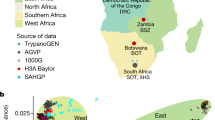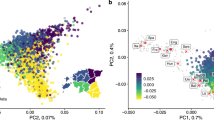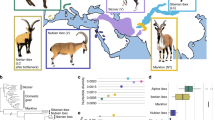Abstract
Understanding how deleterious genetic variation is distributed across human populations is of key importance in evolutionary biology and medical genetics. However, the impact of population size changes and gene flow on the corresponding mutational load remains a controversial topic. Here, we report high-coverage exomes from 300 rainforest hunter-gatherers and farmers of central Africa, whose distinct subsistence strategies are expected to have impacted their demographic pasts. Detailed demographic inference indicates that hunter-gatherers and farmers recently experienced population collapses and expansions, respectively, accompanied by increased gene flow. We show that the distribution of deleterious alleles across these populations is compatible with a similar efficacy of selection to remove deleterious variants with additive effects, and predict with simulations that their present-day additive mutation load is almost identical. For recessive mutations, although an increased load is predicted for hunter-gatherers, this increase has probably been partially counteracted by strong gene flow from expanding farmers. Collectively, our predicted and empirical observations suggest that the impact of the recent population decline of African hunter-gatherers on their mutation load has been modest and more restrained than would be expected under a fully recessive model of dominance.
This is a preview of subscription content, access via your institution
Access options
Access Nature and 54 other Nature Portfolio journals
Get Nature+, our best-value online-access subscription
$29.99 / 30 days
cancel any time
Subscribe to this journal
Receive 12 digital issues and online access to articles
$119.00 per year
only $9.92 per issue
Buy this article
- Purchase on Springer Link
- Instant access to full article PDF
Prices may be subject to local taxes which are calculated during checkout






Similar content being viewed by others
References
Veeramah, K. R. & Hammer, M. F. The impact of whole-genome sequencing on the reconstruction of human population history. Nat. Rev. Genet. 15, 149–162 (2014).
Nielsen, R. et al. Tracing the peopling of the world through genomics. Nature 541, 302–310 (2017).
Henn, B. M., Cavalli-Sforza, L. L. & Feldman, M. W. The great human expansion. Proc. Natl Acad. Sci. USA 109, 17758–17764 (2012).
Charlesworth, B. Fundamental concepts in genetics: effective population size and patterns of molecular evolution and variation. Nat. Rev. Genet. 10, 195–205 (2009).
Lohmueller, K. E. et al. Proportionally more deleterious genetic variation in European than in African populations. Nature 451, 994–997 (2008).
Casals, F. et al. Whole-exome sequencing reveals a rapid change in the frequency of rare functional variants in a founding population of humans. PLoS Genet. 9, e1003815 (2013).
Henn, B. M. et al. Distance from sub-Saharan Africa predicts mutational load in diverse human genomes. Proc. Natl Acad. Sci. USA 113, E440–E449 (2016).
Tennessen, J. A. et al. Evolution and functional impact of rare coding variation from deep sequencing of human exomes. Science 337, 64–69 (2012).
Pedersen, C. T. et al. The effect of an extreme and prolonged population bottleneck on patterns of deleterious variation: insights from the Greenlandic Inuit. Genetics 205, 787–801 (2017).
Lim, E. T. et al. Distribution and medical impact of loss-of-function variants in the Finnish founder population. PLoS Genet. 10, e1004494 (2014).
Fu, W., Gittelman, R. M., Bamshad, M. J. & Akey, J. M. Characteristics of neutral and deleterious protein-coding variation among individuals and populations. Am. J. Hum. Genet. 95, 421–436 (2014).
Xue, Y. et al. Enrichment of low-frequency functional variants revealed by whole-genome sequencing of multiple isolated European populations. Nat. Commun. 8, 15927 (2017).
Peischl, S. et al. Relaxed selection during a recent human expansion. Genetics 208, 763–777 (2018).
Agarwala, V., Flannick, J., Sunyaev, S., Go, T. D. C. & Altshuler, D. Evaluating empirical bounds on complex disease genetic architecture. Nat. Genet. 45, 1418–1427 (2013).
Maher, M. C., Uricchio, L. H., Torgerson, D. G. & Hernandez, R. D. Population genetics of rare variants and complex diseases. Hum. Hered. 74, 118–128 (2012).
Harris, K. & Nielsen, R. The genetic cost of Neanderthal introgression. Genetics 203, 881–891 (2016).
Muller, H. J. Our load of mutations. Am. J. Hum. Genet. 2, 111–176 (1950).
Wright, S. The distribution of gene frequencies in populations. Science 85, 504 (1937).
Kimura, M., Maruyama, T. & Crow, J. F. The mutation load in small populations. Genetics 48, 1303–1312 (1963).
Kimura, M. The Neutral Theory of Molecular Evolution (Cambridge Univ. Press, Cambridge, 1984).
Simons, Y. B. & Sella, G. The impact of recent population history on the deleterious mutation load in humans and close evolutionary relatives. Curr. Opin. Genet. Dev. 41, 150–158 (2016).
Simons, Y. B., Turchin, M. C., Pritchard, J. K. & Sella, G. The deleterious mutation load is insensitive to recent population history. Nat. Genet. 46, 220–224 (2014).
Do, R. et al. No evidence that selection has been less effective at removing deleterious mutations in Europeans than in Africans. Nat. Genet. 47, 126–131 (2015).
Diamond, J. & Bellwood, P. Farmers and their languages: the first expansions. Science 300, 597–603 (2003).
Keinan, A. & Clark, A. G. Recent explosive human population growth has resulted in an excess of rare genetic variants. Science 336, 740–743 (2012).
Bocquet-Appel, J. P. When the world’s population took off: the springboard of the Neolithic Demographic Transition. Science 333, 560–561 (2011).
Cavalli-Sforza, L. L. African Pygmies (Academic, New York, 1986).
Bostoen, K. et al. Middle to Late Holocene paleoclimatic change and the early Bantu expansion in the rain forests of western central Africa. Curr. Anthropol. 56, 354–384 (2015).
Patin, E. et al. Inferring the demographic history of African farmers and pygmy hunter-gatherers using a multilocus resequencing data set. PLoS Genet. 5, e1000448 (2009).
Verdu, P. et al. Origins and genetic diversity of pygmy hunter-gatherers from western central Africa. Curr. Biol. 19, 312–318 (2009).
Veeramah, K. R. et al. An early divergence of KhoeSan ancestors from those of other modern humans is supported by an ABC-based analysis of autosomal resequencing data. Mol. Biol. Evol. 29, 617–630 (2012).
Hsieh, P. et al. Whole-genome sequence analyses of western central African pygmy hunter-gatherers reveal a complex demographic history and identify candidate genes under positive natural selection. Genome Res. 26, 279–290 (2016).
Patin, E. et al. The impact of agricultural emergence on the genetic history of African rainforest hunter-gatherers and agriculturalists. Nat. Commun. 5, 3163 (2014).
Charlesworth, B. & Charlesworth, D. Elements of Evolutionary Genetics (Roberts & Company, Greenwood Village, 2010).
Batini, C. et al. Insights into the demographic history of African pygmies from complete mitochondrial genomes. Mol. Biol. Evol. 28, 1099–1110 (2011).
Quach, H. et al. Genetic adaptation and Neandertal admixture shaped the immune system of human populations. Cell 167, 643–656.e17 (2016).
Gravel, S. et al. Demographic history and rare allele sharing among human populations. Proc. Natl Acad. Sci. USA 108, 11983–11988 (2011).
Pagani, L. et al. Ethiopian genetic diversity reveals linguistic stratification and complex influences on the Ethiopian gene pool. Am. J. Hum. Genet. 91, 83–96 (2012).
Hodgson, J. A., Mulligan, C. J., Al-Meeri, A. & Raaum, R. L. Early back-to-Africa migration into the Horn of Africa. PLoS Genet. 10, e1004393 (2014).
Davydov, E. V. et al. Identifying a high fraction of the human genome to be under selective constraint using GERP++. PLoS Comput. Biol. 6, e1001025 (2010).
Gutenkunst, R. N., Hernandez, R. D., Williamson, S. H. & Bustamante, C. D. Inferring the joint demographic history of multiple populations from multidimensional SNP frequency data. PLoS Genet. 5, e1000695 (2009).
Kim, B. Y., Huber, C. D. & Lohmueller, K. E. Inference of the distribution of selection coefficients for new nonsynonymous mutations using large samples. Genetics 206, 345–361 (2017).
Eyre-Walker, A. & Keightley, P. D. Estimating the rate of adaptive molecular evolution in the presence of slightly deleterious mutations and population size change. Mol. Biol. Evol. 26, 2097–2108 (2009).
Balick, D. J., Do, R., Cassa, C. A., Reich, D. & Sunyaev, S. R. Dominance of deleterious alleles controls the response to a population bottleneck. PLoS Genet. 11, e1005436 (2015).
Gulko, B., Hubisz, M. J., Gronau, I. & Siepel, A. A method for calculating probabilities of fitness consequences for point mutations across the human genome. Nat. Genet. 47, 276–283 (2015).
Mallick, S. et al. The Simons Genome Diversity Project: 300 genomes from 142 diverse populations. Nature 538, 201–206 (2016).
Scholz, C. A. et al. East African megadroughts between 135 and 75 thousand years ago and bearing on early-modern human origins. Proc. Natl Acad. Sci. USA 104, 16416–16421 (2007).
Kim, H. L. et al. Khoisan hunter-gatherers have been the largest population throughout most of modern-human demographic history. Nat. Commun. 5, 5692 (2014).
Skoglund, P. et al. Reconstructing prehistoric African population structure. Cell 171, 59–71.e21 (2017).
Lohmueller, K. E. The impact of population demography and selection on the genetic architecture of complex traits. PLoS Genet. 10, e1004379 (2014).
Fagny, M. et al. The epigenomic landscape of African rainforest hunter-gatherers and farmers. Nat. Commun. 6, 10047 (2015).
Patin, E. et al. Dispersals and genetic adaptation of Bantu-speaking populations in Africa and North America. Science 356, 543–546 (2017).
Perry, G. H. et al. Adaptive, convergent origins of the pygmy phenotype in African rainforest hunter-gatherers. Proc. Natl Acad. Sci. USA 111, E3596–E3603 (2014).
Van der Auwera, G. A. et al. From FastQ data to high confidence variant calls: the Genome Analysis Toolkit best practices pipeline. Curr. Protoc. Bioinformatics 43, 11.10.1–11.10.33 (2013).
Li, H. & Durbin, R. Fast and accurate short read alignment with Burrows–Wheeler transform. Bioinformatics 25, 1754–1760 (2009).
DePristo, M. A. et al. A framework for variation discovery and genotyping using next-generation DNA sequencing data. Nat. Genet. 43, 491–498 (2011).
Hamosh, A., Scott, A. F., Amberger, J. S., Bocchini, C. A. & McKusick, V. A. Online Mendelian Inheritance in Man (OMIM), a knowledgebase of human genes and genetic disorders. Nucleic Acids Res. 33, D514–D517 (2005).
Kousathanas, A., Oliver, F., Halligan, D. L. & Keightley, P. D. Positive and negative selection on noncoding DNA close to protein-coding genes in wild house mice. Mol. Biol. Evol. 28, 1183–1191 (2011).
Purcell, S. et al. PLINK: a tool set for whole-genome association and population-based linkage analyses. Am. J. Hum. Genet. 81, 559–575 (2007).
Lischer, H. E. & Excoffier, L. PGDSpider: an automated data conversion tool for connecting population genetics and genomics programs. Bioinformatics 28, 298–299 (2012).
Excoffier, L. & Lischer, H. E. Arlequin suite ver 3.5: a new series of programs to perform population genetics analyses under Linux and Windows. Mol. Ecol. Resour. 10, 564–567 (2010).
Excoffier, L., Dupanloup, I., Huerta-Sanchez, E., Sousa, V. C. & Foll, M. Robust demographic inference from genomic and SNP data. PLoS Genet. 9, e1003905 (2013).
Lipson, M. et al. Calibrating the human mutation rate via ancestral recombination density in diploid genomes. PLoS Genet. 11, e1005550 (2015).
Fenner, J. N. Cross-cultural estimation of the human generation interval for use in genetics-based population divergence studies. Am. J. Phys. Anthropol. 128, 415–423 (2005).
Ewing, G. & Jensen, J. The consequences of not accounting for background selection in demographic inference. Mol. Ecol. 25, 135–141 (2016).
Schrider, D. R., Shanku, A. G. & Kern, A. D. Effects of linked selective sweeps on demographic inference and model selection. Genetics 204, 1207–1223 (2016).
Eyre-Walker, A. & Keightley, P. D. The distribution of fitness effects of new mutations. Nat. Rev. Genet. 8, 610–618 (2007).
Boyko, A. R. et al. Assessing the evolutionary impact of amino acid mutations in the human genome. PLoS Genet. 4, e1000083 (2008).
Hernandez, R. D. et al. Classic selective sweeps were rare in recent human evolution. Science 331, 920–924 (2011).
Kousathanas, A. & Keightley, P. D. A comparison of models to infer the distribution of fitness effects of new mutations. Genetics 193, 1197–1208 (2013).
Messer, P. W. & Petrov, D. A. Frequent adaptation and the McDonald–Kreitman test. Proc. Natl Acad. Sci. USA 110, 8615–8620 (2013).
Haller, B. C. & Messer, P. W. SLiM 2: flexible, interactive forward genetic simulations. Mol. Biol. Evol. 34, 230–240 (2017).
Gravel, S. When is selection effective? Genetics 203, 451–462 (2016).
Pemberton, T. J. et al. Genomic patterns of homozygosity in worldwide human populations. Am. J. Hum. Genet. 91, 275–292 (2012).
Hussin, J. G. et al. Recombination affects accumulation of damaging and disease-associated mutations in human populations. Nat. Genet. 47, 400–404 (2015).
Landrum, M. J. et al. ClinVar: public archive of relationships among sequence variation and human phenotype. Nucleic Acids Res. 42, D980–D985 (2014).
Alexander, D. H., Novembre, J. & Lange, K. Fast model-based estimation of ancestry in unrelated individuals. Genome Res. 19, 1655–1664 (2009).
Acknowledgements
We thank all the participants for providing the DNA samples used in this study. We thank the Paleogenomics and Molecular Genetics Platform of the Musée de l’Homme-Muséum National d'Histoire Naturelle for technical assistance with DNA sample preparation. We thank G. Laval, L. Excoffier, M. Rotival and S. Ait Kaci Azzou for helpful discussions, and N. Joly for help with computational resources. This work was supported by the Institut Pasteur, Centre National de la Recherche Scientifique and Agence Nationale de la Recherche grant 'AGRHUM' (ANR-14-CE02-0003-01). M.L. was supported by the Fondation pour la Recherche Médicale (FDT20170436932) and A.K. by a Pasteur-Roux fellowship.
Author information
Authors and Affiliations
Contributions
A.K. and M.L. designed the analytical approach and performed the analyses with input from E.P. and L.Q.-M. H.Q. and C.H. performed the experiments. P.M.-D., J.-M.H., A.F., G.H.P., L.B.B. and P.V. collected the samples. L.Q.-M. conceived the study with input from E.P. and obtained funding. The manuscript was written by A.K., M.L., E.P. and L.Q.-M. with input from all authors.
Corresponding authors
Ethics declarations
Competing interests
The authors declare no competing interests.
Additional information
Publisher’s note: Springer Nature remains neutral with regard to jurisdictional claims in published maps and institutional affiliations.
Supplementary information
Supplementary Information
Supplementary notes, figures, tables (1–9) and references
Supplementary Table 10
Clinically relevant variants identified in the exome of African hunter-gathering and farming populations. List of variants annotated with the highest clinical significance in ClinVar database and their frequencies in each of the examined populations
Rights and permissions
About this article
Cite this article
Lopez, M., Kousathanas, A., Quach, H. et al. The demographic history and mutational load of African hunter-gatherers and farmers. Nat Ecol Evol 2, 721–730 (2018). https://doi.org/10.1038/s41559-018-0496-4
Received:
Accepted:
Published:
Issue Date:
DOI: https://doi.org/10.1038/s41559-018-0496-4
This article is cited by
-
African genetic diversity and adaptation inform a precision medicine agenda
Nature Reviews Genetics (2021)
-
Origins of modern human ancestry
Nature (2021)
-
Whole-exome analysis in Tunisian Imazighen and Arabs shows the impact of demography in functional variation
Scientific Reports (2021)
-
Purging of highly deleterious mutations through severe bottlenecks in Alpine ibex
Nature Communications (2020)
-
Understanding Growth and Malnutrition in Baka Pygmy Children
Human Ecology (2020)



